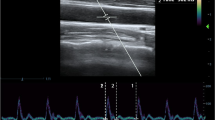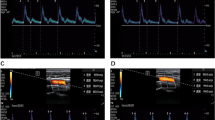Abstract
Hypotension induced by general anesthesia is associated with postoperative complications, increased mortality, and morbidity, particularly elderly patients. The aim of this study was to investigate the effectiveness of corrected carotid artery flow time (FTc) for predicting hypotension following anesthesia induction in patients over 65 years old. After faculty ethical committee approval and written informed consent, 138 patients (65 years and older, ASA physical status I–III) who scheduled for elective surgery were included in this study. In the pre-operative anesthesia unit, the carotid artery FTc value was measured by ultrasound and hemodynamic values were recorded. Following anesthesia induction with propofol, hemodynamic data were recorded at 1-minute intervals for 3 min. Measurements were terminated prior to endotracheal intubation, as direct laryngoscopy and endotracheal intubation could cause sympathetic stimulation and hemodynamic changes. Hypotension occurred in 52 patients (37.7%). The preoperative FTc value of the patients who developed hypotension was statistically lower (312.5 ms) than the patients who did not (345.0 ms) (p < 0.001). The area under the ROC curve for carotid artery FTc was 0.93 (95% CI for AUC:0.89–0.97; p < 0.001) with an optimal cut-off of value for predicting post-anesthesia hypotension 333 ms, a sensitivity of 90.4% and a specificity of 84.9%. As a result of the multiple logistic regression model, carotid artery FTc emerged as the sole independent risk factor for hypotension following anesthesia induction. Preoperative carotid artery FTc measurement is a simple, bedside, noninvasive, and reliable method for predicting anesthesia-induced hypotension in elderly patients.




Similar content being viewed by others
Data availability
No datasets were generated or analysed during the current study.
References
Futier E, Lefrant JY, Guinot PG, Godet T, Lorne E, Cuvillon P, Bertran S, Leone M, Pastene B, Piriou V, Molliex S, Albanese J, Julia JM, Tavernier B, Imhoff E, Bazin JE, Constantin JM, Bruno P, Jaber S, INPRESS Study Group. Effect of individualized vs standard blood pressure management strategies on postoperative organ dysfunction among high-risk patients undergoing major surgery: a randomized clinical trial. JAMA. 2017;318(14):1346–57. https://doi.org/10.1001/jama.2017.14172.
Yokose M, Takaki R, Mihara T, Saigusa Y, Yamamoto N, Masui K, Goto T. Hypotension after general anesthesia induction using remimazolam in geriatric patients: protocol for a double-blind randomized controlled trial. PLoS ONE. 2022;17(9):e0275451. https://doi.org/10.1371/journal.pone.0275451.
Myrberg T, Lindelöf L, Hultin M. Effect of preoperative fluid therapy on hemodynamic stability during anesthesia induction, a randomized study. Acta Anaesthesiol Scand. 2019;63(9):1129–36. https://doi.org/10.1111/aas.13419.
Legrand M, Kothari R, Fong N, Palaniappa N, Boldt D, Chen LL, Kurien P, Gabel E, Sturgess-DaPrato J, Harhay MO, Pirracchio R, Bokoch MP. VEGA-1 trial investigators 2023 Norepinephrine versus phenylephrine for treating hypotension during general anaesthesia in adult patients undergoing major noncardiac surgery: a multicentre, open-label, cluster-randomised, crossover, feasibility, and pilot trial. Br J Anaesth. 2023;130(5):519–27. https://doi.org/10.1016/j.bja.2023.02.004.
Ma IWY, Caplin JD, Azad A, Wilson C, Fifer MA, Bagchi A, Liteplo AS, Noble VE. Correlation of carotid blood flow and corrected carotid flow time with invasive cardiac output measurements. Crit Ultrasound J. 2017;9(1):10. https://doi.org/10.1186/s13089-017-0065-0.
Kimura A, Suehiro K, Juri T, Tanaka K, Mori T. Changes in corrected carotid flow time induced by recruitment maneuver predict fluid responsiveness in patients undergoing general anesthesia. J Clin Monit Comput. 2022;36(4):1069–77. https://doi.org/10.1007/s10877-021-00736-7.
Kim HJ, Choi YS, Kim SH, Lee W, Kwon JY, Kim DH. Predictability of preoperative carotid artery-corrected flow time for hypotension after spinal anaesthesia in patients undergoing caesarean section: a prospective observational study. Eur J Anaesthesiol. 2021;38(4):394–401. https://doi.org/10.1097/EJA.0000000000001376.
Maitra S, Baidya DK, Anand RK, Subramanium R, Bhattacharjee S. Carotid artery corrected flow time and respiratory variations of peak blood flow velocity for prediction of hypotension after induction of general anesthesia in adult patients undergoing elective surgery: a prospective observational study. J Ultrasound Med. 2020;39(4):721–30. https://doi.org/10.1002/jum.15151.
Wodey E, Carre F, Beneux X, Schaffuser A, Ecoffey C. Limits of corrected flow time to monitor hemodynamic status in children. J Clin Monit Comput. 2000;16(3):223–8. https://doi.org/10.1023/a:1009981024804.
Shokoohi H, Berry GW, Shahkolahi M, King J, King J, Salimian M, Poshtmashad A, Pourmand A. The diagnostic utility of sonographic carotid flow time in determining volume responsiveness. J Crit Care. 2017;38:231–5. https://doi.org/10.1016/j.jcrc.2016.10.025.
Hossein-Nejad H, Mohammadinejad P, Lessan-Pezeshki M, Davarani SS, Banaie M. Carotid artery corrected flow time measurement via bedside ultrasonography in monitoring volume status. J Crit Care. 2015;30(6):1199–203. https://doi.org/10.1016/j.jcrc.2015.08.014.
Beier L, Davis J, Esener D, Grant C, Fields JM. Carotid ultrasound to predict fluid responsiveness: a systematic review. J Ultrasound Med. 2020;39(10):1965–76. https://doi.org/10.1002/jum.15301.
Antiperovitch P, Iliescu E, Chan B. Carotid systolic flow time with passive leg raise correlates with fluid status changes in patients undergoing dialysis. J Crit Care. 2017;39:83–6. https://doi.org/10.1016/j.jcrc.2017.02.017.
Barjaktarevic I, Chiem A, Cannesson M. Time to correct the flow of corrected flow time. Crit Ultrasound J. 2017;9(1):18. https://doi.org/10.1186/s13089-017-0076-x.
Chen Y, Liu Z, Fang J, Xie Y, Zhang M, Yang J. Correlation of carotid corrected flow time and respirophasic variation in blood flow peak velocity with stroke volume variation in elderly patients under general anaesthesia. BMC Anesthesiol. 2022;22(1):246. https://doi.org/10.1186/s12871-022-01792-5.
Kim DH, Shin S, Kim N, Choi T, Choi SH, Choi YS. Carotid ultrasound measurements for assessing fluid responsiveness in spontaneously breathing patients: corrected flow time and respirophasic variation in blood flow peak velocity. Br J Anaesth. 2018;121(3):541–9. https://doi.org/10.1016/j.bja.2017.12.047.
Wang J, Li Y, Su H, Zhao J, Tu F. Carotid artery corrected flow time and respiratory variations of peak blood flow velocity for prediction of hypotension after induction of general anesthesia in elderly patients. BMC Geriatr. 2022;22(1):882. https://doi.org/10.1186/s12877-022-03619-x.
Mohammadinejad P, Hossein-Nejad H. Calculation of corrected flow time: Wodey’s formula vs. Bazett’s formula. J Crit Care. 2017;44:154–5. https://doi.org/10.1016/j.jcrc.2017.10.046.
Singer M, Allen MJ, Webb AR, Bennett ED. Effects of alterations in left ventricular filling, contractility, and systemic vascular resistance on the ascending aortic blood velocity waveform of normal subjects. Crit Care Med. 1991;19(9):1138–45. https://doi.org/10.1097/00003246-199109000-00008.
Acknowledgements
Assistance with the special article: the authors would like to thank to True Editors Customer Service (order 4458) for English editing of this study.
Funding
The authors declare that no funds, grants, or other support were received during the preparation of this manuscript.
Author information
Authors and Affiliations
Contributions
All authors contributed to the study conception and design. Material preparation, data collection and analysis were performed by ID, MT, EG, YKA, and MO. The first draft of the manuscript was written by ID and MT, all authors commented on previous versions of the manuscript. All authors read and approved the final manuscript.
Corresponding author
Ethics declarations
Competing interests
The authors have no relevant financial or non-financial interests to disclose.
Ethical approval
This study was performed in line with the principles of the Declaration of Helsinki. The approval for this study was obtained from the institutional review board of Cukurova University Ethics Committee (Date: Jan/06/2023, IRB number: 129/10).
Consent to participate
Our study did NOT use any diagnostic images (x-rays, laparoscopic images, ultrasound images, brain scans, pathology slides, etc.) or any part of the participants' bodies.
Additional information
Publisher’s Note
Springer Nature remains neutral with regard to jurisdictional claims in published maps and institutional affiliations.
Rights and permissions
Springer Nature or its licensor (e.g. a society or other partner) holds exclusive rights to this article under a publishing agreement with the author(s) or other rightsholder(s); author self-archiving of the accepted manuscript version of this article is solely governed by the terms of such publishing agreement and applicable law.
About this article
Cite this article
Demir, I., Turktan, M., Gulec, E. et al. The predictive role of carotid artery flow time for anesthesia-induced hypotension in high-risk elderly patients. J Clin Monit Comput (2024). https://doi.org/10.1007/s10877-024-01145-2
Received:
Accepted:
Published:
DOI: https://doi.org/10.1007/s10877-024-01145-2




